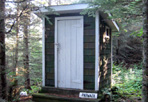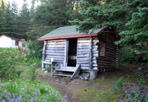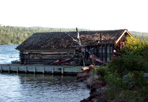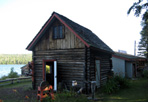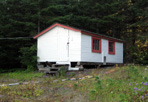
Edisen Fishery
Rock Harbor
By: Toupal, Stoffie, and Zedeno
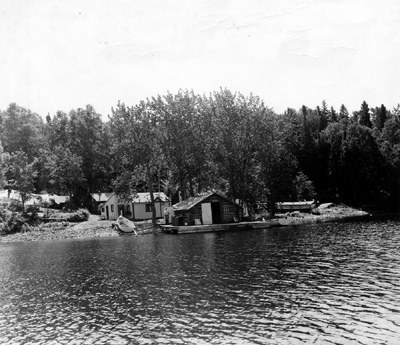
Edisen Fishery, 1962: [NVIC: 60-044], ISRO Archives.
he Edisen Fishery is a historic folk fish camp located at the south end of Rock Harbor. Named for its last fisherman, Pete Edisen, the site contains the only on-fish-camp-site interpretive center. Other fishermen and their families had used the camp before Pete and his wife Laura. Louis Mattson and John Anderson constructed the Edisen residence and fished there from around 1890 through 1904. In 1905, they sold their buildings and docks to Mike Johnson and his family. They had adopted Laura so when the Johnson families relocated to Star Island in 1938, Pete and Laura took over the fish camp. From Mattson-Anderson fishery to Johnson fishery, this site came to be known among fishermen as Pete's and Laura's, and Pete Edisen's place.
The Edisen Fishery extends from a small bay at the mouth of the channel to Moskey Basin to an area bounded by the Rock Harbor lighthouse, Middle Islands, and Greenstone Ridge across the channel. The site includes a land base surrounding Pete's and Laura's buildings, the Rock Harbor lighthouse, and the area between the two establishments. The fish camp structures include the main house, the fish house and dock, a variety of outbuildings, and the Rock Harbor lighthouse.
Located at the south end of Rock Harbor and with immediate access to the lake, the Edisen Fishery is adjacent to one of the longest-used water routes in the Island's history and has always received many visitors. It is connected, consequently, to other places on the Island through family relations, but particularly to Star Island near the midpoint of Rock Harbor where the Johnson families moved in 1938. It is ironic that the location actually contributed to that move. By the 1950s, the sport fishing pressure had increased to a level that motivated the Park Service to reduce the number of "commercial" fishing nets. In spite of the Johnsons' tenure at the Edisen Fishery, they did not hold title the land, but had an interest by virtue of occupancy of land owned by Cora Broadwell. The Johnsons had to yield to the Park Service's decision.
Mike and Nellie Johnson signed a quitclaim deed in exchange for a life lease. It was understood by E.G. Willemin and George Baggley that it would be Pete Edisen who continued fishing from the base. However, it was the older couple Mike and Nellie Johnson who were granted the life lease. Mike Johnson died in 1944 joining his wife who had already passed away. At this time George Baggley issued a Special Use Permit for Pete Edisen. Pete and Laura remained at the site presumably through this cooperative arrangement with the Park Service to act as demonstrators of a functioning fish camp for the visiting public. The Edisens also supplied the Rock Harbor Lodge with fresh fish for its guests. The couple continued to live and fish from the site under this arrangement until they died.[2]
The Edisen Fishery is the most intact surviving example of a small, family-operated commercial fishery in continuous use in the park. It was in operation from 1910-1975 and represents a once common lifestyle on Lake Superior.[3]
Image Gallery
Site Map
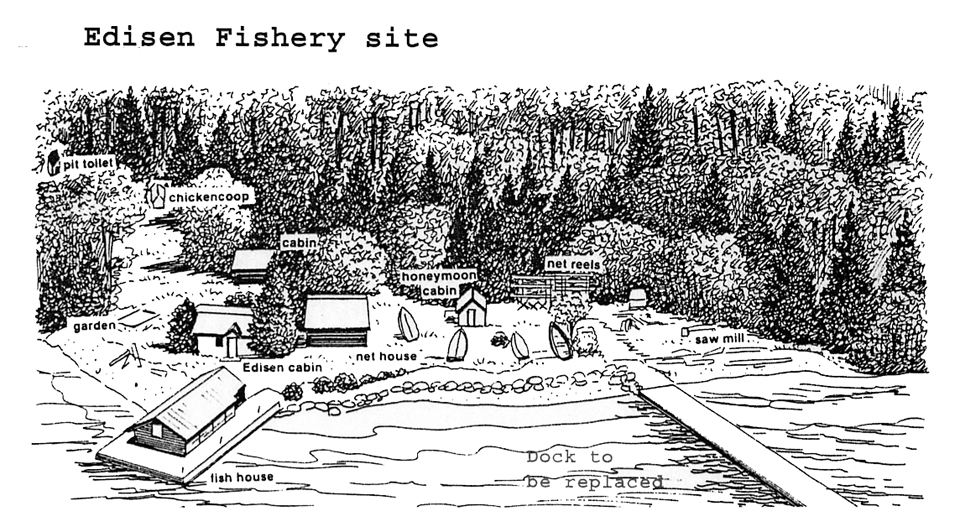
Edisen Fishery Site Map: Isle Royale National Park.
Help Tell The Story
Are you related to this family? Would you be willing to share stories or photos associated with related events? If so, we would love to hear from you! Please contact the Cultural Resource Manager at Isle Royale National Park. Or write to:

800 East Lakeshore Drive
Houghton, Michigan 49931-1896
906-482-0984
Citations
- National Park Service Cultural Landscapes Inventory. 2010. Edisen Fishery. Park Historic Architecture and Cultural Landscapes Program, U.S. National Park Service.
- Newland, Dave. 2003. Executive Summary of the Johnson Life Lease. Isle Royale National Park. Houghton, MI.
- Toupal, Rebecca S., Richard W. Stoffie, and M. Nieves Zedeno. The Isle Royale Folkefiskerisamfunn: Familier som levde av fiske: An Ethnohistory of the Scandinavian Folk Fishermen of Isle Royale National Park. Report for the National Park Service, Midwest Regional Office. Tucson: Bureau of Applied Research in Anthropology, University of Arizona, 2002.
![Pete Edisen, 1961: Linn [NVIC: 60-007], ISRO Archives.](../../Rock_Tobin_Harbor/Edisen/Jpegs/Small/NVIC-60-007.jpg)
![Pete Edisen, 1961: Linn [NVIC: 60-008], ISRO Archives.](../../Rock_Tobin_Harbor/Edisen/Jpegs/Small/NVIC-60-008.jpg)
![Pete Edisen, 1961: Linn [NVIC: 60-893], ISRO Archives.](../../Rock_Tobin_Harbor/Edisen/Jpegs/Small/NVIC-60-893.jpg)
![Edisen Fishery, 1962: [NVIC: 60-044], ISRO Archives.](../../Rock_Tobin_Harbor/Edisen/Jpegs/Small/NVIC-60-044.jpg)
![Edisen Fishery, 1962: [NVIC: 60-383], ISRO Archives.](../../Rock_Tobin_Harbor/Edisen/Jpegs/Small/NVIC-60-383.jpg)
![Edisen Net Reels, ca. 1965: [NVIC: 60-442], ISRO Archives.](../../Rock_Tobin_Harbor/Edisen/Jpegs/Small/NVIC-60-442.jpg)
![Edisen Fishery, 1969: Haas [NVIC: 60-838], ISRO Archives.](../../Rock_Tobin_Harbor/Edisen/Jpegs/Small/NVIC-60-838.jpg)
![Edisen Fishery, 1960s: [NVIC: 60-854], ISRO Archives.](../../Rock_Tobin_Harbor/Edisen/Jpegs/Small/NVIC-60-854.jpg)

